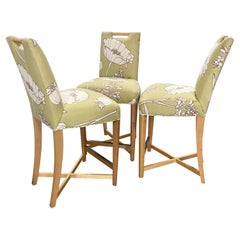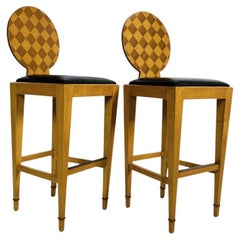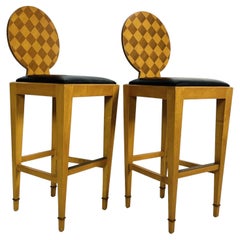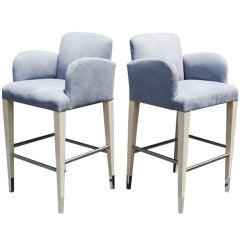Donghia Barstool
Early 2000s American Stools
Fabric, Wood
1990s American Modern Stools
Textile, Wood
Recent Sales
1990s American Modern Stools
Textile, Wood
Late 20th Century American Stools
21st Century and Contemporary American Modern Stools
Fabric, Wood
21st Century and Contemporary American Modern Stools
Fabric, Wood
People Also Browsed
2010s Italian Modern Chandeliers and Pendants
Metal, Brass
21st Century and Contemporary American Sofas
Linen, Velvet
2010s American Modern Stools
Wood, Oak
2010s Italian Modern Chandeliers and Pendants
Brass
20th Century American Modern Lounge Chairs
Wicker, Cane, Mahogany, Walnut
2010s French Modern Tables
Enamel
Antique Mid-19th Century English High Victorian Taxidermy
Other
Donghia for sale on 1stDibs
With distinctive style touches like gray flannel upholstery and overstuffed seating, American designer Angelo Donghia (1935–85) was a visionary leader of bold interior design and furniture in the 1970s and ’80s. Although Donghia lived only to age 50, by the time of his death from AIDS-related pneumonia, his name graced numerous furniture and decor companies, in addition to his own interior designs.
After graduating from Parsons School of Design in 1959, Donghia joined the interiors firm of Yale R. Burge, and his star rose quickly from there. By 1963, he had been appointed vice president and in 1966, partner — a move that came with a name change for the firm to Burge-Donghia Interiors. In 1968, he founded the fabrics and wall coverings company & Vice Versa, and in 1978 he founded Donghia Furniture. With this holistic approach, Donghia was able to oversee nearly every element of an interior design project, which, for him, spanned everything from corporate offices (notably PepsiCo’s world headquarters in Purchase, New York) to the Metropolitan Opera Club at Lincoln Center to residential interiors for clients such as Diana Ross and Ralph Lauren.
After he inherited Burge’s firm, he continued to develop its reach as Donghia Associates. He opened a series of showrooms around the country to offer his designs to a wider audience, who loved the company’s marriage of minimal forms with luxe materials. His silver-foil ceilings, mixing of eclectic textile patterns and plush furniture set trends and, through mass marketing, influenced the direction of American interior design.
“I feel that I’ve developed my own style that is as classic and minimal as the ’30s style it reflects,” the designer once told New York magazine. In 2015, the retrospective “Angelo Donghia: Design Superstar” at the New York School of Interior Design chronicled his influence on all facets of modern interiors, from furnishings to wall coverings. It’s an approach that still resonates today. Donghia continued to operate as a company after his death, acquired by the Rubelli Group in 2005. After it filed for bankruptcy in 2020 and closed its showrooms, its name, designs, archives and inventory were acquired by Kravet.
Find authentic Donghia furniture today on 1stDibs.
Finding the Right Stools for You
Stools are versatile and a necessary addition to any living room, kitchen area or elsewhere in your home. A sofa or reliable lounge chair might nab all the credit, comfort-wise, but don’t discount the roles that good antique, new and vintage stools can play.
“Stools are jewels and statements in a space, and they can also be investment pieces,” says New York City designer Amy Lau, who adds that these seats provide an excellent choice for setting an interior’s general tone.
Stools, which are among the oldest forms of wooden furnishings, may also serve as decorative pieces, even if we’re talking about a stool that is far less sculptural than the gracefully curving molded plywood shells that make up Sōri Yanagi’s provocative Butterfly stool.
Fawn Galli, a New York interior designer, uses her stools in the same way you would use a throw pillow. “I normally buy several styles and move them around the home where needed,” she says.
Stools are smaller pieces of seating as compared to armchairs or dining chairs and can add depth as well as functionality to a space that you’ve set aside for entertaining. For a splash of color, consider the Stool 60, a pioneering work of bentwood by Finnish architect and furniture maker Alvar Aalto. It’s manufactured by Artek and comes in a variety of colored seats and finishes.
Barstools that date back to the 1970s are now more ubiquitous in kitchens. Vintage barstools have seen renewed interest, be they a meld of chrome and leather or transparent plastic, such as the Lucite and stainless-steel counter stool variety from Indiana-born furniture designer Charles Hollis Jones, who is renowned for his acrylic works. A cluster of barstools — perhaps a set of four brushed-aluminum counter stools by Emeco or Tubby Tube stools by Faye Toogood — can encourage merriment in the kitchen. If you’ve got the room for family and friends to congregate and enjoy cocktails where the cooking is done, consider matching your stools with a tall table.
Whether you need counter stools, drafting stools or another kind, explore an extensive range of antique, new and vintage stools on 1stDibs.



